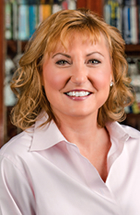Why Can’t a Woman Be President of The U.S.?
An article by Sandy Franks
It wouldn’t be a big surprise if you’ve never heard of Victoria Claflin Woodhull. Though she was the first woman to run for president (in 1872, with Frederick Douglass as her running mate), her campaign received zero electoral votes, rendering whatever popular votes her campaign received fruitless.

Here is one likely reason why you’ve not heard of her: she didn’t make headlines because she wasn’t allowed to.
But another fact just as impressive as Woodhull’s presidential run is that she was the first woman to both operate a brokerage firm on Wall Street and found a newspaper.
So many accomplishments for a woman in the late nineteenth century, huh? So why aren’t her contributions better recognized today?
The answer is simple: Woodhull, at the time, existed in male-dominated realms – the stock market, the print industry and politics. Her achievements were being consistently overshadowed by those of the men around her, men who’d always had complete access and privileges in these cutthroat fields. To many men, Woodhull’s presence was insignificant, if not a laughing matter.
This predicament of Woodhull’s – being discounted for her knowledge in certain areas, if not punished or berated for it – mirrors those experienced by women in the science, technology, mathematics, economics and marketing worlds of today.
Last week I wrote about how the big institutions – Google and AT&T – alongside universities across the nation, are creating computer science programs designed specifically to encourage the enrollment of young women.
Though men have traditionally occupied jobs in the computer science field, studies show that women determine most of the consumer trends online. Women also use social media more often than men. So it makes perfect sense for women to step up into the big tech positions in order to help their companies better understand their female audience.
And that’s not to assume that women in these fields should simply take on women-related company roles. Consider how the world of mathematics (geometry in particular) will change for the better with Maryam Mirzakhani’s contribution. Does her incredible accomplishment as a woman in mathematics now necessitate the emergence of “a woman’s role in mathematics”?
The fine line exists here: Should women be recognized for their contributions as women? Or is the ultimate goal for women and their accomplishments to be recognized on a basis so regular that the need to make a point of their sex no longer exists? These are interesting questions to keep in mind.
Presently, we’re still celebrating women in unconventional fields.
For example, Layla Masri. She is the founder of the Washington, D.C.-based tech company Bean Creative, which she started 17 years ago – at a time when being a woman in tech was even rarer than it is today.
Layla says that she was often mistaken by those who didn’t know the nature of her real occupation as the “cute little marketing girl” who was brought in to get clients to sign contracts. Imagine the surprise on their faces when she told them, “Um, no. I’m actually a programmer.”
Instead of being offended by their comments as the “cute marketing girl”, she decided to “own it” and use it as a discussion prompt. “I realized I could continue to be offended by it,” says Masri, “or I could just use it as an education point for everyone else.”
Another good example of a woman breaking down the STEM gender stereotypes is that of Catherine Simpson. She’s the founder and owner of Catherine’s Auto Repair. Growing up in Atlanta, Catherine first went to school at Westminster, and later to Georgetown University in Washington, DC.
After college, she moved to Seattle to work as a teen counselor. Her dream wasn’t to open her own auto repair shop, although she did feel the need for a change in that regard. What helped push her into the field of auto mechanics was the result of how she was treated, or rather mistreated, when she took her car in for repair. She was often talked down to as though she were completely incapable of understanding what was being explained about her car.
Boy, don’t we all know that feeling.
Finally, having suffered this type of presumptuous maltreatment one too many times, Catherine decided to do something about it. She signed up for a 5-month course on basic trades skills for women, after which, having come to the conclusion that if she excelled in car mechanics, she’d likely succeed in business as well, she opened her own auto repair shop. She started with a job as a trainee in a transmission shop, and then continued working as a mechanic and manager at several places over the next 4 years.
After all of this necessary experience and education, Catherine decided it was time to open her own shop – one that now has two locations.
Catherine states that her goal isn’t to stand out as a woman who owns an auto repair shop; rather, she wants (and gets) simple notoriety for being a reliable service provider to her customers.
Indeed, the ever-growing presence of women in male-dominated fields is a sign of positive change. But let’s make sure that their accomplishments, they’re innovations, don’t go unrecognized like Victoria Claflin Woodhull’s did. That would be a shame; perhaps even evidence that the writing of history-books is a male-dominated field…
Sandy Franks
Publisher, The Women’s Financial Edge and Crusader for Women’s Rights to Wealth
